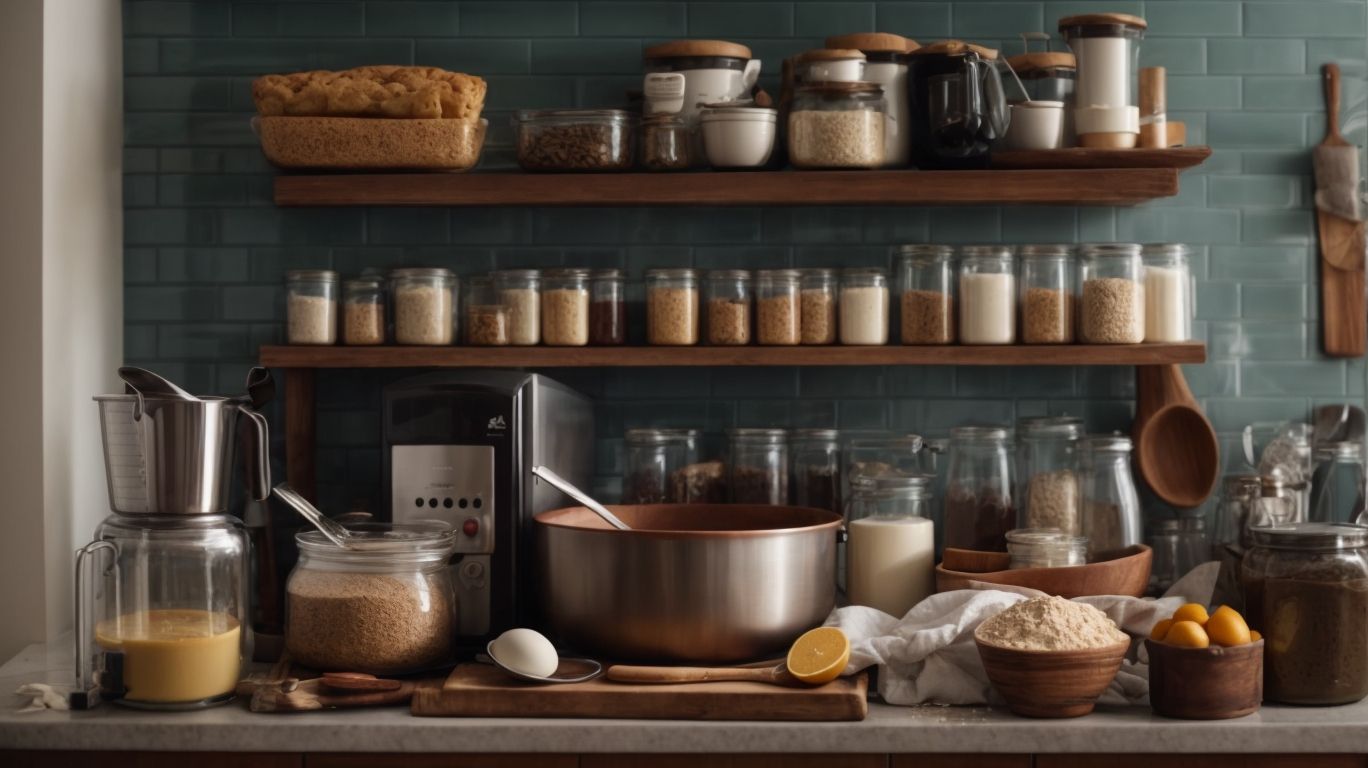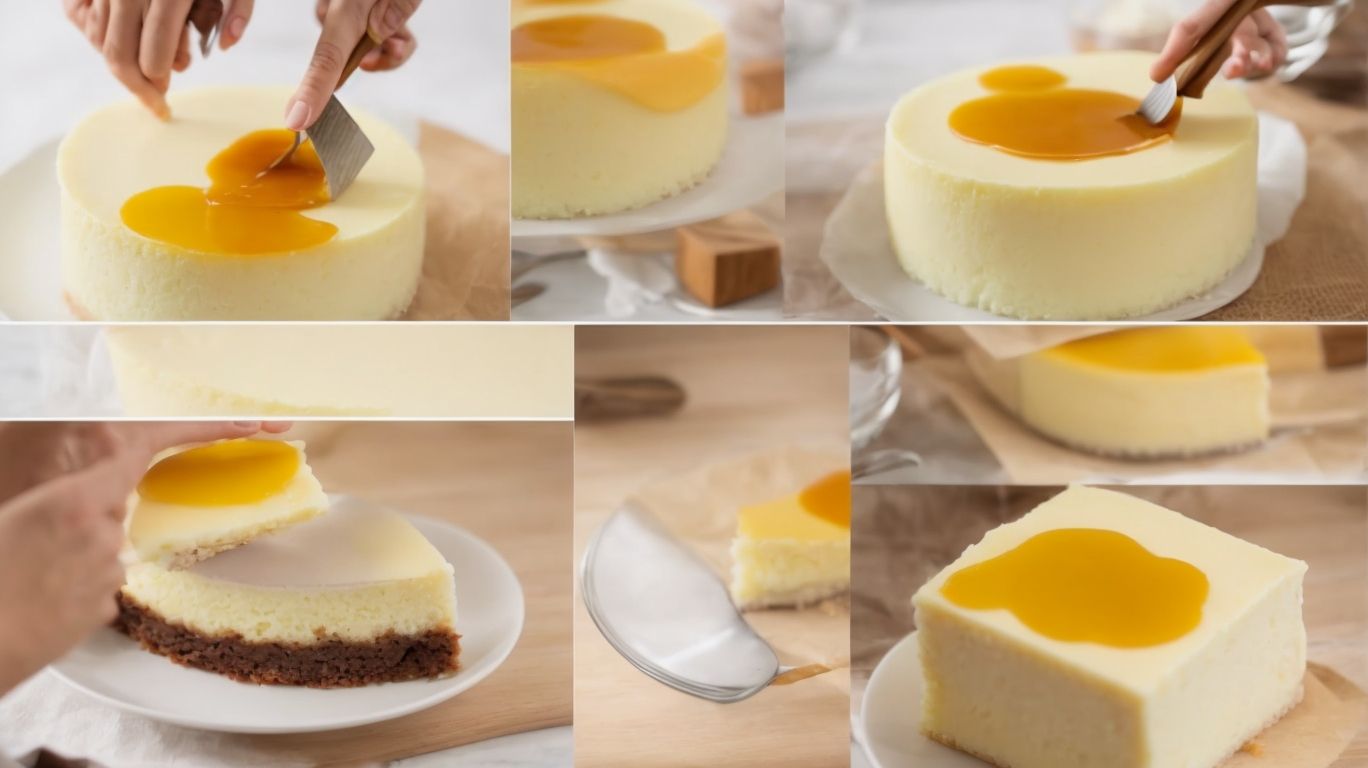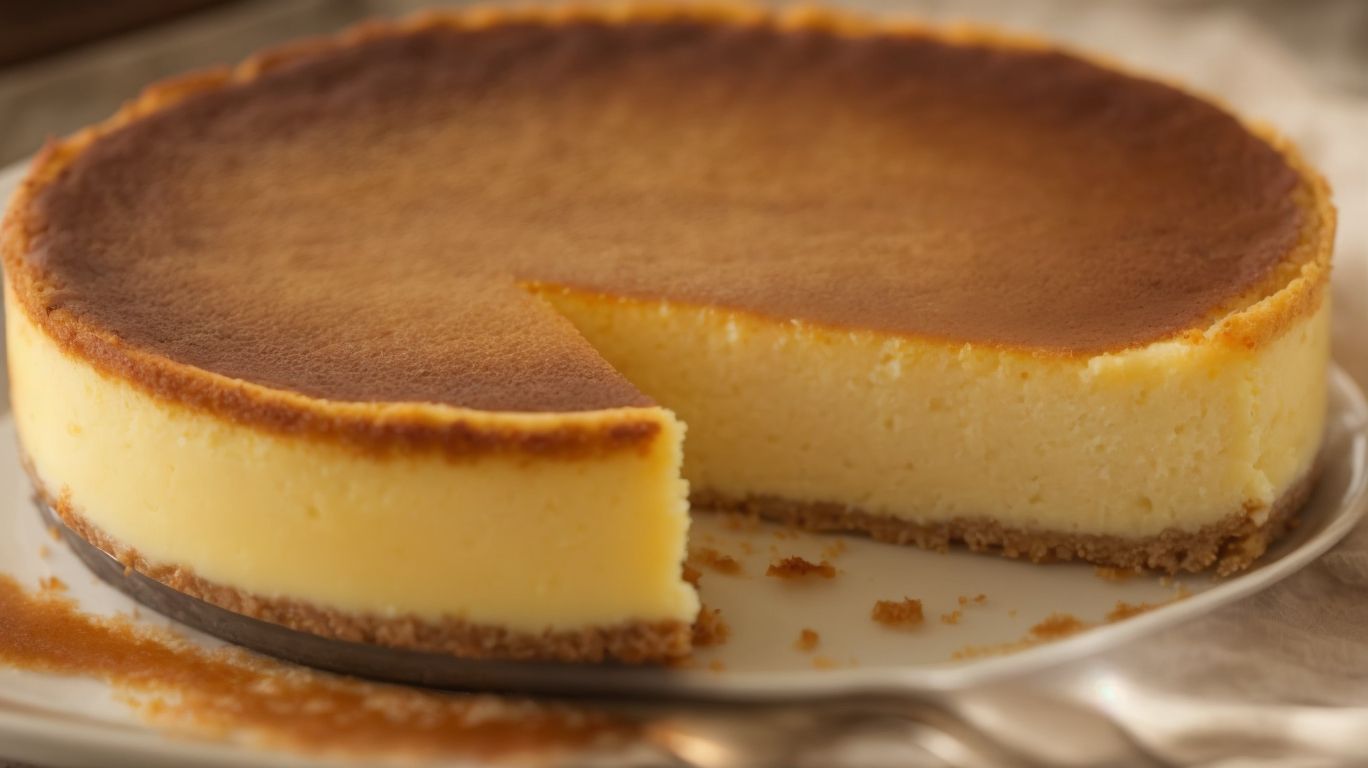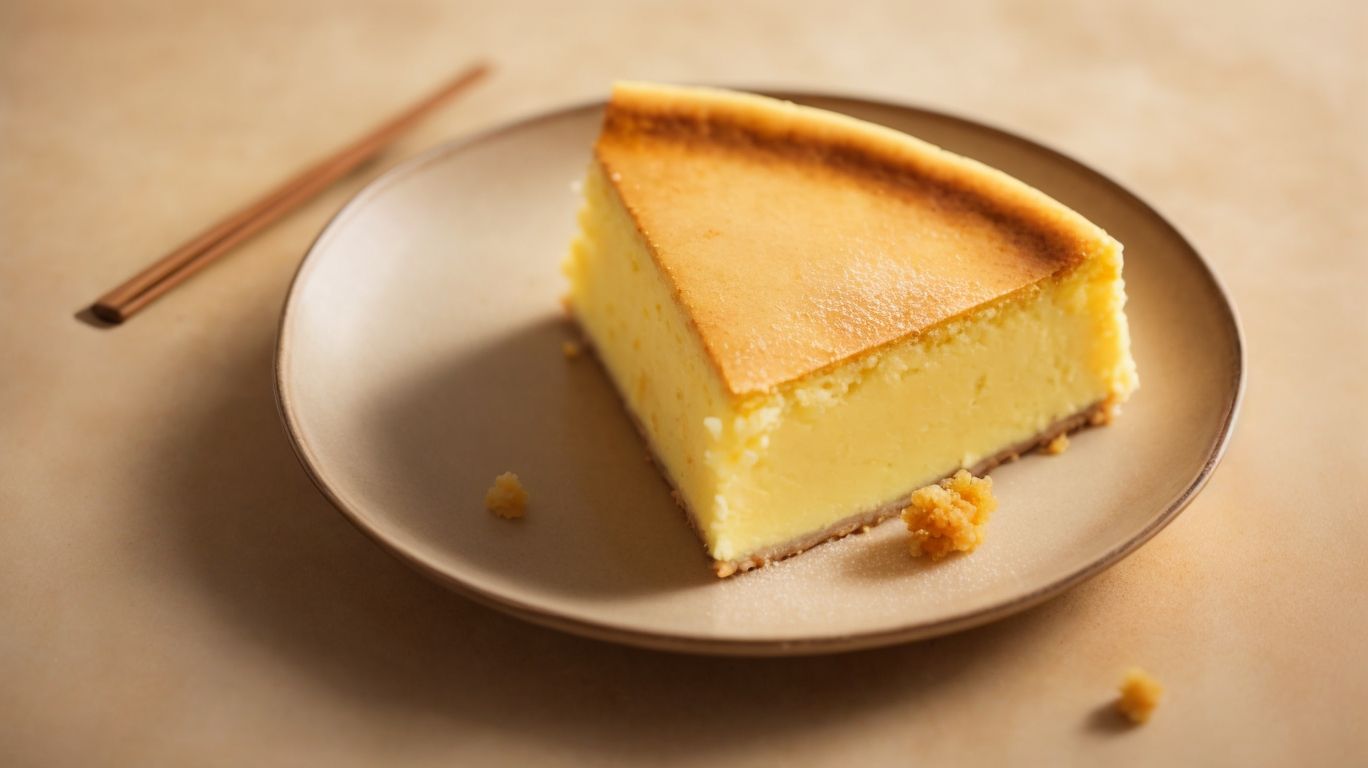How to Bake Japanese Cheesecake?
Japanese cheesecake is a delightful and light dessert that is sure to impress your friends and family.
This article will guide you through baking a delicious Japanese cheesecake step by step. From preparing the pan to troubleshooting tips for common issues like cracked or sunk cheesecakes, we’ve got you covered.
We’ll explore variations and additions like matcha green tea or chocolate swirl cheesecake. Stay tuned for tips and tricks to ensure the perfect Japanese cheesecake every time. Let’s get baking!
Key Takeaways:
About Japanese Cheesecake
Japanese Cheesecake is a delightful dessert known for its fluffy and airy texture, making it a popular choice among dessert enthusiasts. Crafting the perfect Japanese cheesecake involves a delicate balance of ingredients and techniques to achieve that signature jiggly consistency.
The origins of Japanese cheesecake can be traced back to the Hakata region of Japan, where it first gained popularity for its unique spin on the classic cheesecake. What sets Japanese cheesecake apart is its lighter texture compared to its rich and dense Western counterparts. Combining cream cheese with a hint of matcha powder and a touch of baking powder creates the perfect balance of flavors in this delicate dessert.
Key components of a Japanese cheesecake recipe include premium quality cream cheese, farm-fresh eggs, a precise amount of sugar to enhance sweetness, and a gentle folding technique to incorporate air into the batter.
Ingredients and Equipment

Credits: Poormet.Com – Jose Young
When preparing a Japanese cheesecake, having the right ingredients and equipment is crucial to ensure a successful outcome. From creamy cream cheese to fluffy eggs, each component plays a vital role in creating the perfect cheesecake.
For a delectable Japanese cheesecake, high-quality cream cheese is key. It should be softened to room temperature to ensure a smooth batter. Fresh, organic eggs are also essential, providing structure and richness to the cake.
A touch of lemon juice adds a subtle tanginess that balances the sweetness. Using parchment paper to line the cake pan ensures easy removal and a clean presentation.
Equip yourself with a sturdy cake pan, a trusty whisk for proper mixing, and several mixing bowls for efficient organization. These tools are essential for achieving a light and airy texture in your Japanese cheesecake.
What You’ll Need
To create a delectable Japanese cheesecake, you’ll need a variety of ingredients such as cake flour, eggs, cream cheese, and a hint of lemon zest for a burst of freshness.
The combination of these ingredients creates the light, fluffy texture that Japanese cheesecakes are known for. It’s crucial to use fresh eggs to achieve that perfect rise and airy consistency. Ensure the cream cheese is at room temperature to blend smoothly without any lumps. Additionally,
- apricot jam
- fine mesh strainer
is ideal for a light glaze on top, adding a subtle fruity element to balance the sweetness, and a fine mesh strainer comes in handy for that velvety smooth batter. Incorporating these ingredients in precise quantities is key to mastering this delicate dessert.
Equipment Required
For the preparation of a Japanese cheesecake, essential equipment such as a quality cake pan, sturdy whisk, and reliable mixing bowls are essential tools to ensure a smooth baking process.
Another crucial item that significantly aids in the baking process is a double boiler, which helps in melting and combining ingredients gently without burning or overheating.
Using parchment paper to line the cake pan offers several benefits; it ensures easy release of the delicate cheesecake, prevents sticking, and facilitates effortless cleanup.
Don’t forget to place the prepared cake pan on a baking sheet before placing it in the oven to catch any potential drips or spills during the baking process.
Step-by-Step Instructions

Credits: Poormet.Com – Kenneth Allen
Mastering the art of creating a Japanese cheesecake requires following precise step-by-step instructions, from preparing the batter to baking it to perfection and finally cooling and serving the delightful dessert.
Once you have gathered the necessary ingredients, start by preheating your oven and preparing a bain-marie. This water bath technique ensures that the cheesecake bakes gently and evenly without browning too quickly.
Next, beat cream cheese and sugar until smooth, then add in flour and corn starch to achieve the perfect texture. Incorporate the eggs one at a time, mixing well after each addition.
After pouring the batter into the pan, place it in the bain-marie in the oven. Bake until the edges are set and the center has a slight jiggle; this slow baking process is crucial for a silky smooth texture.
Preparing the Pan
The first step in creating a flawless Japanese cheesecake is preparing the pan by lining it with parchment paper and lightly greasing it with butter to ensure easy removal and a pristine presentation.
Butter not only enhances the flavor but also plays a crucial role in preventing the cheesecake from sticking to the pan. It adds a rich, buttery essence to the cake while aiding in achieving a beautiful golden crust.
To further ensure a smooth release post-baking, dusting the greased pan with a mixture of Mochiko and cornstarch can be beneficial. This coating not only adds a subtle additional flavor but also acts as an extra barrier between the cake and the pan, simplifying the unmolding process.
Making the Batter
Creating the velvety batter for a Japanese cheesecake involves skillfully blending eggs, cream cheese, and a touch of matcha powder or cocoa powder for a unique twist on this classic dessert.
To achieve the desired smooth and lump-free texture, it is crucial to gradually add King Arthur flour to the mixture while continuously whisking. This ensures that the flour incorporates evenly, preventing any clumps from forming. The incorporation of creme brulee as a flavor enhancer adds a delightful caramelized touch to the cheesecake, elevating its taste profile. Remember to use room temperature ingredients as cold ones can lead to an uneven batter consistency. Maintaining a thorough mixing process will result in a silky batter ready to be baked to perfection.
Baking the Cheesecake
The baking stage is critical in the Japanese cheesecake process, as it involves precise temperature control and the use of a water bath to ensure the cheesecake rises evenly and achieves that signature fluffy texture with a firm peak meringue topping.
One key aspect to note during the baking process in making a Japanese cheesecake is the delicate balance of oven temperature. The Plaza Hotel in Japan, famous for its exceptional cheesecakes, emphasizes the importance of maintaining a consistent heat level to prevent cracks or a sunken middle in the cake.
Utilizing a water bath is another secret technique that contributes to the success of Japanese cheesecakes. By placing the cake pan in a larger pan filled with hot water, the gentle heat surrounds the cheesecake and allows it to cook more evenly without browning too quickly.
Cooling and Serving
Once the Japanese cheesecake is baked to perfection, allow it to cool gradually before serving, adding a touch of elegance with fresh strawberries and a glossy apricot jam glaze for a delightful finishing touch.
Proper cooling is crucial to ensure that the delicate texture of the cheesecake sets perfectly. To enhance the presentation, consider cutting the cheesecake into elegant slices and arranging them on a platter adorned with vibrant strawberries. For a burst of flavor, gently heat apricot jam until it forms a smooth glaze, then drizzle it over the slices before serving. This not only elevates the taste but also adds a visually appealing touch to the dessert. If you prefer a light, airy texture reminiscent of chiffon cake, incorporate a pinch of cream of tartar into the batter during baking for a delightful variation.
Troubleshooting Tips

Credits: Poormet.Com – Noah Sanchez
Encountering issues like cracks, deflation, or browning on top of your Japanese cheesecake can be frustrating, but with the right troubleshooting tips, you can overcome these challenges and achieve a picture-perfect dessert.
For cracked tops, one common issue could be the sudden temperature change during baking. To prevent this, try placing a shallow pan of water on the rack below the cake. This will create a steamy environment that helps the top stay smooth.
If your cake collapses, it may be due to overmixing the batter. Keep the mixing gentle to maintain the airy structure.
Uneven browning often occurs when your oven has hot spots. Simply rotate your cake halfway through baking or consider investing in an oven thermometer for more precise control.
Cracked Cheesecake
Dealing with a cracked cheesecake can be disheartening, but understanding the reasons behind the cracks, such as improper meringue preparation or sudden temperature changes, can help prevent this issue and ensure a beautifully risen dessert.
One common reason for cracked Japanese cheesecakes is overly stiff or soft meringue. Achieving the right consistency is crucial for a flawless bake. Opening the oven door frequently during baking can lead to a sudden drop in temperature, causing cracks to form on the delicate surface. To address these issues, ensure that the meringue is properly whipped to stiff peaks but still glossy. Also, try to resist the temptation to peek into the oven too often, allowing the cheesecake to bake undisturbed.
Sinking Cheesecake
A sinking cheesecake can be salvaged by identifying factors like overbrowned surfaces or undercooked centers, allowing you to troubleshoot and save your dessert with techniques such as adjusting baking times or achieving a firmer peak meringue.
One common reason for a Japanese cheesecake to sink is the delicate balance of its batter, often exemplified in chiffon cakes. The incorporation of air through the meringue is vital for the cake’s structure. If the meringue is underbeaten or not stable enough, the cake can collapse post-baking. Adding a touch of lemon juice during meringue preparation can enhance stability and prevent sinking. Ensuring that the cake is baked at the right temperature and for the correct duration is crucial. Adjusting these factors can lead to a flawless, tall Japanese cheesecake that impresses every time.
Overbrowned Cheesecake
An overbrowned cheesecake may result from excessive heat exposure or uneven baking, but by employing strategies like tenting with foil or reducing oven temperatures, you can rectify the browning issue and achieve a uniformly golden top.
One common mistake that often leads to overbrowned Japanese cheesecakes is setting the oven temperature too high, causing the top to darken before the center is fully cooked. Another factor could be using a dark-colored pan that absorbs more heat, leading to uneven browning. To address this, consider using a light-colored or glass pan for more even heat distribution.
If you find your cheesecake browning too quickly, a useful technique is to cover the top with a tent of aluminum foil once it reaches the desired level of browning. This foil tent helps prevent further darkening while allowing the cheesecake to continue cooking internally.
Variations and Additions
Exploring variations and additions to the traditional Japanese cheesecake opens up a world of exciting possibilities, from indulgent matcha green tea twists to decadent chocolate swirls and vibrant fruit toppings that elevate the dessert experience.
One creative adaptation that is gaining popularity is infusing the classic Japanese cheesecake with the rich flavors of creme brulee, adding a delightful caramelized touch to the velvety texture.
For those seeking a refreshing twist, incorporating a hint of zesty lemon juice into the cheesecake batter creates a tangy and bright flavor profile that perfectly complements the creamy base.
Experimenting with a variety of seasonal fruits like strawberries, blueberries, or passion fruit as toppings allows for a customizable and visually appealing presentation that caters to individual preferences.
Matcha Green Tea Cheesecake
Infusing the delicate flavor of matcha green tea into your cheesecake recipe can yield a beautifully aromatic and subtly earthy dessert reminiscent of traditional Japanese chiffon cakes.
When incorporating matcha into your Japanese cheesecake, it’s crucial to strike the right balance of sweetness and bitterness. This can be achieved by using a combination of cornstarch and cocoa powder to help enhance the matcha essence in the dessert. The cornstarch helps create a light and airy texture, while the cocoa powder adds a hint of richness that complements the earthy notes of the matcha. Remember to sift the matcha powder to ensure a smooth and lump-free incorporation into the cheesecake batter. By doing so, you can create a harmonious fusion of flavors that pays homage to the cultural significance of matcha in Japanese cuisine.
Chocolate Swirl Cheesecake
Adding luscious chocolate swirls to your cheesecake elevates the dessert with rich, decadent flavors, creating a delightful contrast to the light and airy Basque or NY Style cheesecake base.
One way to achieve those elegant chocolate swirls is by using a technique known as ‘marbling.’ To do this, prepare the cheesecake batter and melt some high-quality chocolate separately. Once both mixtures are ready, pour the cheesecake batter into the baking pan and then drizzle the melted chocolate on top.
Next, take a skewer or a toothpick and gently swirl the chocolate through the batter to create a beautiful marbled effect. This not only adds a visual appeal to your cheesecake but also infuses each bite with a burst of chocolatey goodness.
Fruit Toppings
Enhancing your cheesecake with vibrant fruit toppings like fresh strawberries or a glossy apricot jam glaze not only adds visual appeal but also introduces a burst of fruity flavors that complement the creamy richness of the dessert.
Regarding decorating your Japanese cheesecake, the possibilities are endless. The contrast between the light, airy cake and the juicy, colorful fruits creates a harmonious balance that tantalizes the senses.
- Imagine a luscious mango glaze cascading down the sides, adding a tropical twist to your cake.
- Alternatively, you can opt for a mix of berries for a vibrant, tangy flavor explosion.
Consider experimenting with different textures too – a sprinkle of toasted coconut for crunch or a dollop of creme brulee for a decadent touch.
Tips and Tricks for the Perfect Japanese Cheesecake
Achieving the perfect Japanese cheesecake requires mastering a range of tips and tricks, from precise baking techniques to optimal oven temperature control, ensuring that each slice embodies the fluffy, jiggly essence of this beloved dessert.
One crucial aspect for perfecting Japanese cheesecakes lies in selecting high-quality ingredients such as Bonne Maman cream cheese, fine Japanese flour, and fragrant vanilla extract. Remember to have all ingredients at room temperature to ensure smooth incorporation during the mixing process.
- Regarding baking methods, using a water bath technique can help prevent cracks on the cake’s surface, maintaining its delicate texture.
- For troubleshooting, if your cheesecake cracks or doesn’t rise evenly, try adjusting the oven temperature or decreasing the baking time slightly for better results.
- Consider experimenting with different flavor variations, such as matcha or citrus-infused Japanese cheesecakes, for a unique twist on this classic dessert.
Conclusion
The art of crafting a Japanese cheesecake is a delightful journey filled with fluffy textures, rich flavors, and endless possibilities for creative adaptations.
One of the reasons why Japanese cheesecakes have gained immense popularity is their unique balance of lightness and creaminess, making them stand out among other cheesecake varieties. The incorporation of cream of tartar in the recipe adds a subtle tanginess and helps achieve that characteristic airy, yet rich, consistency.
When following renowned pastry chef, Kat Lieu’s advice, bakers often experiment with different techniques to master the perfect jiggle and bouncy texture that are signature attributes of Japanese cheesecakes.
Frequently Asked Questions
1. How to Bake Japanese Cheesecake?
To bake a Japanese cheesecake, you will need cream cheese, sugar, eggs, milk, butter, flour, cornstarch, and vanilla extract. Mix the cream cheese, sugar, and milk in a double boiler until smooth. Slowly add in the eggs, followed by the melted butter and vanilla extract. Finally, add in the flour and cornstarch and mix until well combined. Pour the batter into a greased cake pan and bake in a water bath at 320 degrees Fahrenheit for about an hour.
2. Can I use other types of cheese for Japanese cheesecake?
While traditionally, cream cheese is used for Japanese cheesecake, you can also experiment with other types of cheese such as mascarpone or ricotta. Just make sure to adjust the amount of sugar accordingly as these cheeses may have a different level of sweetness.
3. How do I prevent my Japanese cheesecake from cracking?
The key to preventing cracks in your Japanese cheesecake is to bake it in a water bath. This helps to regulate the temperature and prevent the cake from drying out too quickly. Additionally, make sure to properly mix the ingredients and avoid overmixing, which can also cause cracks.
4. How can I add flavor to my Japanese cheesecake?
Aside from the traditional vanilla flavor, you can add in other ingredients such as matcha powder, chocolate, or fruit purees to give your Japanese cheesecake a unique flavor. Just make sure to adjust the amount of sugar accordingly to balance out the flavors.
5. How do I know when my Japanese cheesecake is done baking?
You can test the doneness of your Japanese cheesecake by inserting a toothpick into the center. If it comes out clean, then the cake is done. The edges should also be slightly golden brown and the center should have a slight jiggle when gently shaken.
6. Can I make a Japanese cheesecake without a water bath?
It is recommended to use a water bath when baking a Japanese cheesecake to prevent cracks and ensure even baking. However, if you do not have a large enough pan for a water bath, you can place a tray of water on the bottom rack of your oven to create a similar effect.

